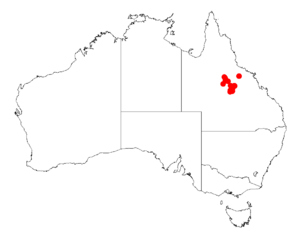Acacia microcybe facts for kids
Quick facts for kids Acacia microcybe |
|
|---|---|
| Scientific classification | |
| Genus: |
Acacia
|
| Species: |
microcybe
|
 |
|
| Occurrence data from AVH | |
Acacia microcybe is a type of shrub or small tree that belongs to the Acacia family. It is found only in a specific part of north-eastern Australia. This plant is considered to be of "Least Concern" by the Nature Conservation Act 1992. This means it is not currently at risk of disappearing.
What it Looks Like
This plant usually grows to be about 3 to 10 meters (10 to 33 feet) tall. It has dark grey bark that often has small cracks in it. Its branches are a bit hairy and can sometimes look scaly.
Like most Acacia plants, Acacia microcybe does not have regular leaves. Instead, it has special leaf-like parts called phyllodes. These phyllodes are slightly hairy and stay green all year. They are long and thin, measuring about 6 to 14 centimeters (2.4 to 5.5 inches) long and 1 to 3 millimeters (0.04 to 0.12 inches) wide. They can be straight or slightly curved and have many faint lines running along them.
How it Got its Name
The Acacia microcybe was first officially described by a botanist named Leslie Pedley in 1978. At that time, he called it Acacia microcephala. Later, in 1987, it was reclassified and given a different name, Racosperma microcephalum.
Finally, in 2006, Leslie Pedley changed its name back to Acacia microcybe. This happened as part of his research published in a science journal called Austrobaileya.
Where it Grows
This plant grows in a small area in North West Queensland, Australia. You can find it north and north-west of a town called Aramac. It prefers to grow in hard, stony, clay soils that are a bit alkaline (meaning they are not acidic).

